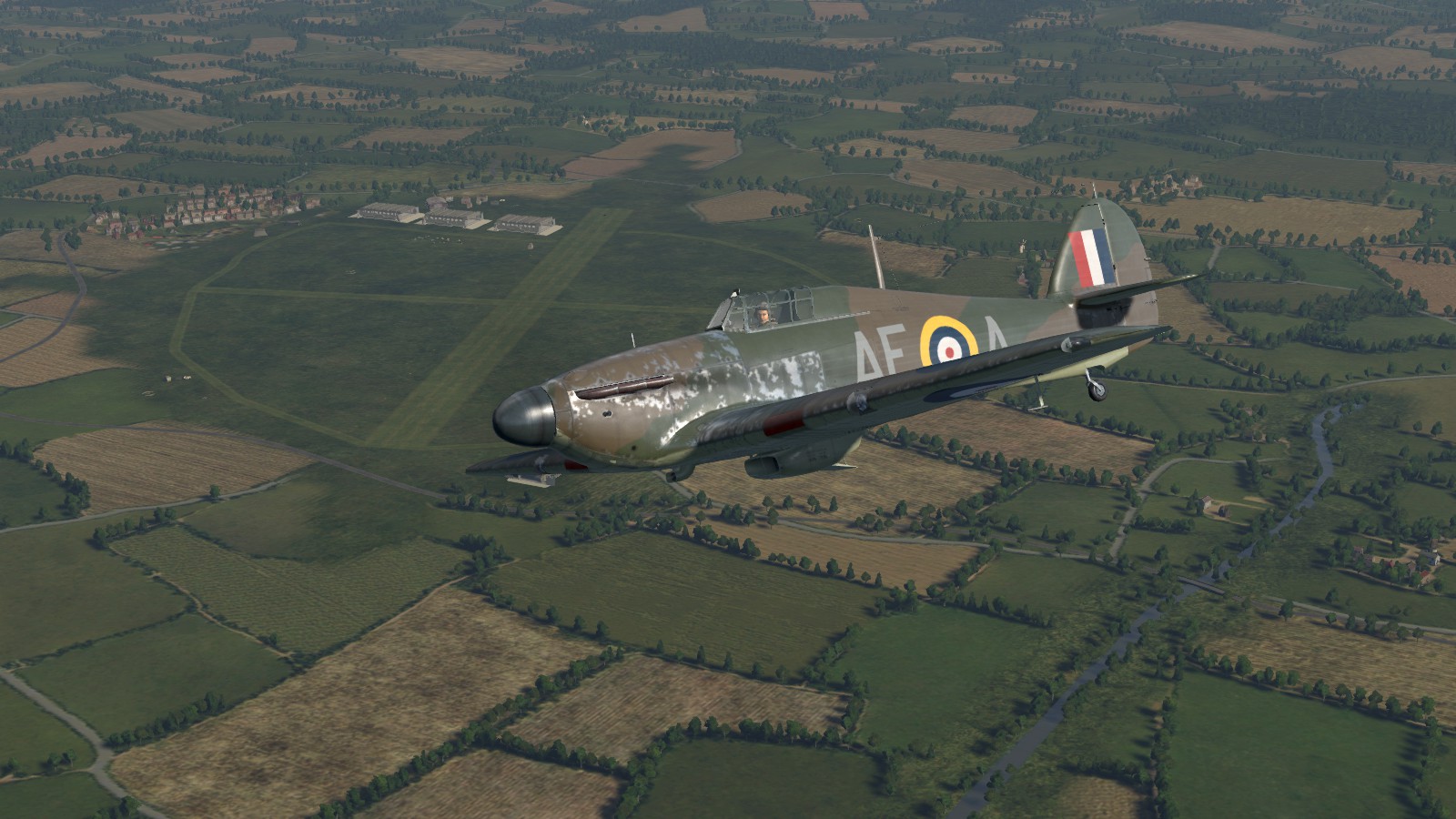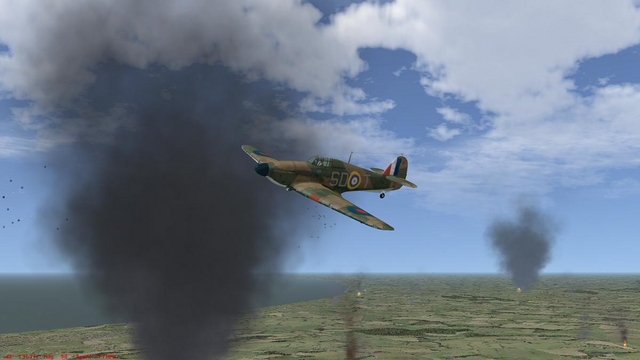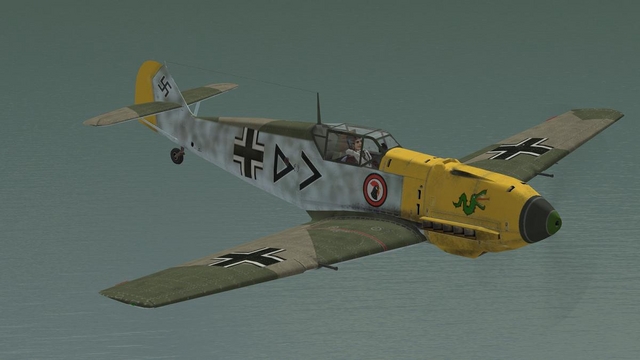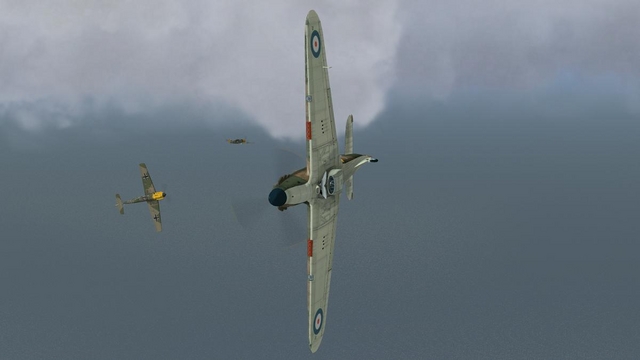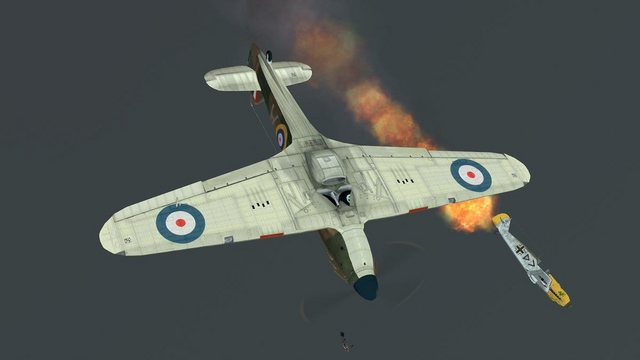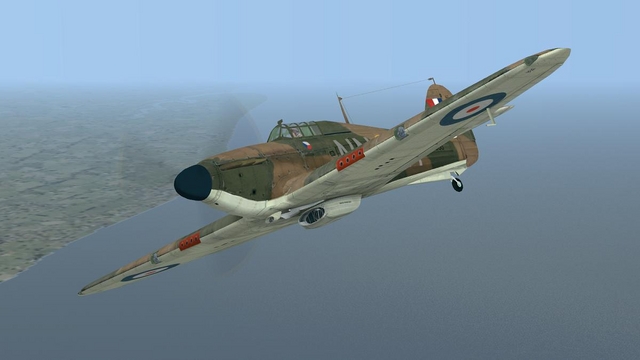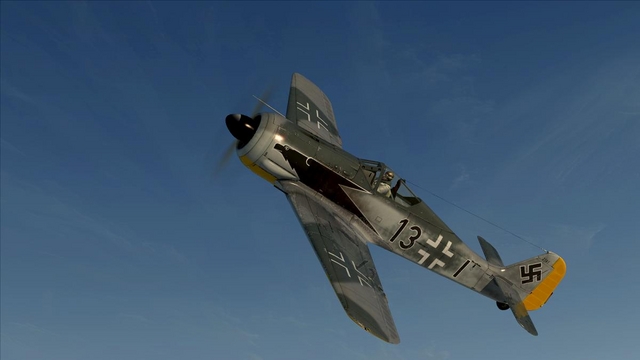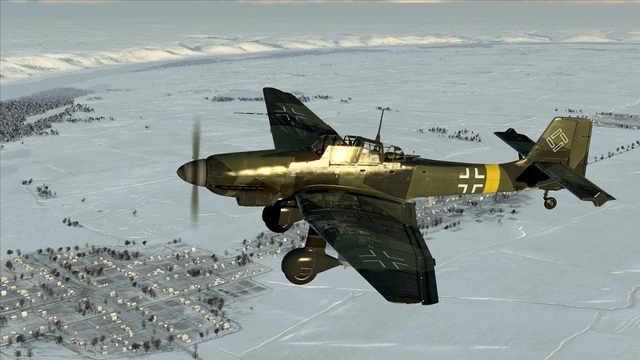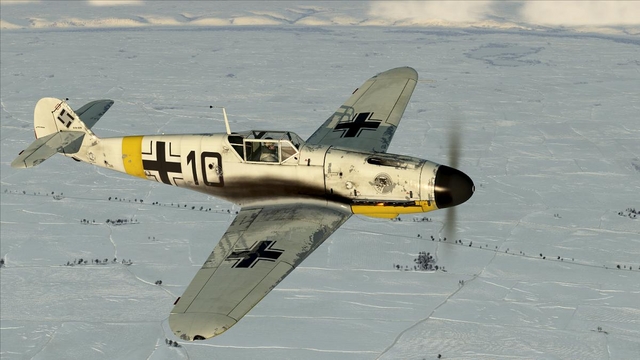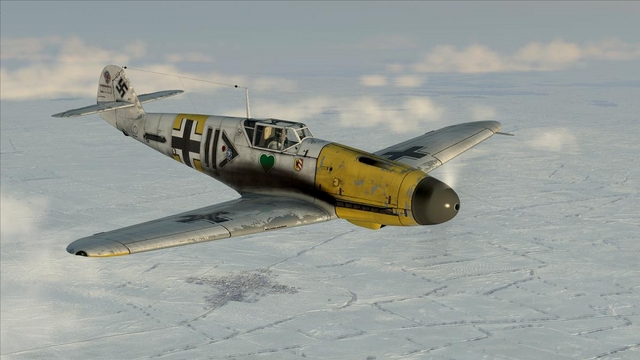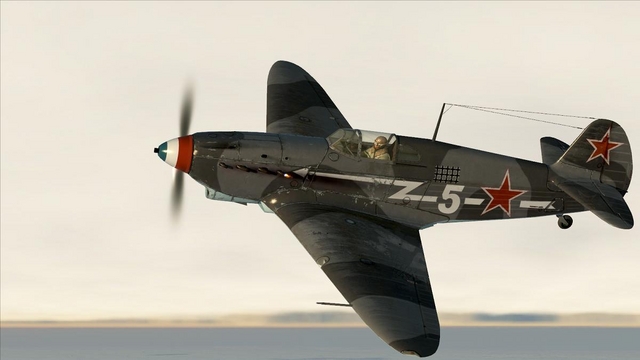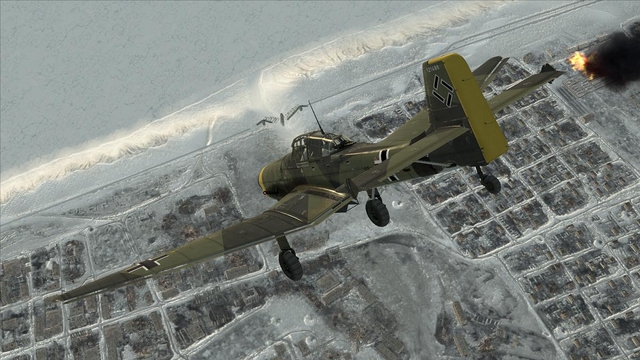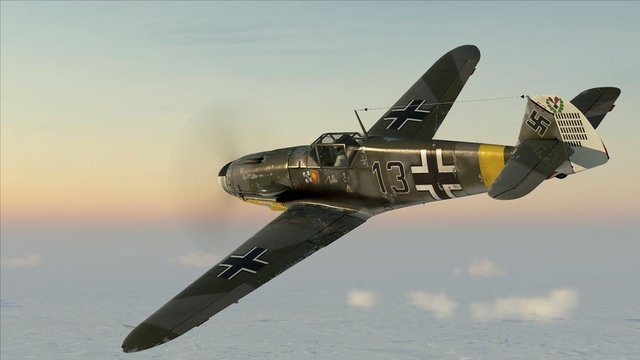-
Content count
3,749 -
Joined
-
Last visited
-
Days Won
7
Content Type
Profiles
Forums
Calendar
Gallery
Downloads
Store
Everything posted by 33LIMA
-
Flying the Ju 87 in Il-2: Battle of Stalingrad! Having flown a Stalingrad Stuka campaign mission in Il-2 '46, it's time to repeat the process, this time in the new sim devoted to the famous battle. My first time playing through the BoS Single Player campaign, I've been sticking to flying the Yak-1, in an approximation of a conventional pilot career. While BoS doesn't support multiple virtual pilots, each active with a given squadron, you can fly any aircraft you choose on any campaign mission. Rather than 'switching sides' as well as planes in mid-campaign, I decided to start over at the beginning of the first 'chapter' of BoS's Stalingrad campaign, 'Prelude to Counteroffensive'. This BoS allows the player to do, with the option to 'fast forward' to the current campaign 'Chapter', enabling me to resume my Yak career at any time I chose. The only active German airfield at the start of the campaign is Gumrak, which became one of the two main active airfields within the Stalingrad pocket, after 6th Army was cut off there. Having chosen to fly the Ju 87 from Gumrak, I was offered a choice of mission type and from those available, chose 'Bombing'. As you can see, the other options are 'Ground attack' and 'Ground support'. Apparently the latter is a form of close air support or air cover for ground forces, but I'm not sure what the distinction is between 'Bombing' and 'Ground attack'...especially for a Stuka! And here's the mission I've been allocated. I am to bomb a supply dump well into Soviet-held territory, across the River Volga to the east of Stalingrad itself. At this stage, I have no other details of the mission. In the 'Plane setup' screen I reviewed my options. I haven't flown the Stuka much outside of single missions so havent 'unlocked' any skin or equipment options. Perhaps because I've chosen a bombing mission, I don't have the usual choiced of bombload, either. All I can carry is an SC 1000, which from memory is a 2000 pound thin-skinned HE bomb, no use for attacking targets that need any knd of penetration but with excellent blast effects. Just one bomb but a big load for a Stuka! And here's the full mission briefing screen. At the same time as choosing a bombing mission, I had also picked an air start ('Short' mission duration). I much prefer ground starts but the BoS AI just cannot reliably handle takeoffs in laden Stukas! As I mentioned in the previous Stuka mission report, most of the time, the AI crack up, shortly after takeoff. The dive bombing single mission that ships with BoS puts the player at the head of a flight of six Stukas and once when I flew it, four out of five AI planes managed to avoid a crash. But that seems to be exceptional, so I'm glad I got a screenshot or two, if only to prove to myself I didn't imagine it! As I usually do before a mission, I zoomed in on the map at the target area and planned my approach and 'action on the objective'. This being an air start, the mission would begin with my flight at the right altitude and lined up on the last leg to the target area. As for said target, I wasn't quite sure what a 'supply dump' might look like but at least this one was located in a spot which I thought should be easy to identify, even from my planned approach height of 3500 metres...weather permitting, or course. In BoS, thanks to cloud cover, the weather often isn't very permissive of target acquisition from altitude, and the mission brief's weather notes said nothing about this important factor. So I decided that I would fly direct to the target, bombing it straight off my line of approach if I managed to get 'eyes on'. If not, I would overfly the target, turn 180 degrees and try again. If that didn't work, I would descend below the cloudbase and attack from there, likely in a shallow dive. Plan made! Time to head off the the flight line and get cracking! ...to be continued!
-
Bombs away...or bomb away, actually... As I came up to the point where I would begin my dive, the verdammter clouds once more obscured the target! I decided to take a chance and dive in blind, aiming for the spot where I'd last seen the cratered supply dump and trusting with my virtual life my 1000 metre cloud ceiling estimate. I'm not sure where these descriptions originated, that describe Stukas rolling inverted to begin their dive. I don't doubt that Stukas were strong and fully aerobatic and their crews well-trained. But this was a big, heavily-laden, not especially powerful aircraft. My sources - which I'll mention at the end of this report - say that Stukas either just bunted forwards into a dive from level flight, or peeled off left or right into the dive, perhaps after pulling up slightly. Rolling inverted seems to me an extravagant manouevre to put a bombed-up Stuka through, not least as any turbulence, disorientation or imprecise handling could see the aircraft barrel-rolling into the path of other attacking aircraft. Banking or bunting onto a target isn't going to break your line of sight much (if any) worse than rolling upside down and takes you quickly and safely down and directly out of formation. So that's how I dive bomb. I chopped the throttle, held the nose level and then as the speed dropped off, popped out the dive brakes. Unlike Il-2 '46 - which seems to expect you to start your dive bombing from level flight - extending my dive brakes did not automatically initiate the dive. So I pushed the stick smartly forward and put her nose hard down. Fairly quickly, my Stuka was enveloped in whiteness as I dropped into the clouds. Even in a sim, diving steeply earthwards with the ground filling your field of view is a bit scary. Now, I was diving into cloud and couldn’t even see the ground. I remembered the flight of Stukas practicing before WW2 which had dived to destruction in what turned out to be a layer of ground mist. Would I come out of cloud high enough to pull out? If so, would I be near enough to the target to complete the attack? Fortunately, the answer to both questions was 'Yes', just about. I came out of cloud at over 1000 meters but to one side of the crater which marked my target - or so I hoped, for I was assuming my flight-mate had bombed accurately. I had to roll around and ease off my dive angle, to get my nose onto the target. As I came up to the supply dump, I let go my bomb, for whose fuse, during setup, I had wisely selected a 5-second delay. Bomb gone, I pulled up, closed my dive brakes and opened my throttle. As I soared up and away, there was a satisfyingly large explosion behind as my 1000 kilogram weapon went off, pretty well on target! Small fires flared briefly around the point of impact. If cloud had prevented me from dive-bombing off my line of approach, I had planned to come around and try again from the opposite direction. And that's exactly what I had done! Although the cloud cover had rather messed up my dive, I had recovered sufficiently to be able to place my weapon pretty well right where I wanted it. And as planned, I was now heading back north, to relative safety. Passing the northern edge of town, I was about to order my flight to reform when I saw a train below. Conscious of the chance I was taking, I decided to strafe him; just one run, I promised myself. I banked around in a 180 degree turn and and came in west to east, along the line of the tracks. The clag from the locomotive acted as a rather good smoke screen but I cut loose into the middle of it and was rewarded by the sight of some splinters flying. You can't expect too much from a pair of rifle-calibre machine guns. Pulling up and away, it was my turn to be hit - Soviet trains in these here parts seem rather well defended by flatcars with MGs and light flak. Suddenly, my Stuka was making almost as much smoke as that loco! Worse, one of my flight-mates staggered over the railway line and cracked up in the snow near the train! I gathered my bearings and turned west, climbing gently and then leveling off just at the cloudbase. Here, I throttled back, determined to coax as much life as I could from my engine, which was running well enough but likely losing oil and/or coolant. I ordered my last flight-mate - wherever he now was - to return to base but heard no acknowledgement. If he had survived, there was no point in him tagging along with my crippled bird. Better that he took his chances separately. As it happened, his chances were not looking terribly good. Coming under fire from some light and medium flak, I decided to climb to just above the cloud level, giving me some cover from the ground as well as something I could dive into, if attacked from the air. I flitted into and out of the higher stretches of cloud. Suddenly, over the radio, came a cacophony of calls from friendly fighters, reporting an air combat. At least two kills were claimed. As it happened, our escort was making short work of a pair of Yaks that had evidently attempted an interception, somewhere out of sight. Plodding slowly on, I expected my motor to seize up and stop at any moment, so I had headed due west, to get as close as I could to the Volga and friendly ground forces. But my temperatures stayed off the wrong end of the scales and so I steered around, coming onto a course further south, towards our assigned exit waypoint. Partly this was for the 'gamey' reason that hitting this waypoint was a mission success criterion and/or linked to earning more 'experience points', but also because, well, that was the plan, and it was more likely that my escort and/or wingman would be heading that way, too. Safety in numbers they say and I was feeling rather isolated and vulnerable. If attacked, all I could do now was duck into the nearest clouds. I scanned anxiously left and right, looking for landmarks in the frozen landscape and alert for any threats. After what seemed an eternity I saw the Volga ahead and soon recognised the Stalingrad suburb of Krasnoarmeysk, where lay my exit waypoint. To the west, the cloud cover seemed a little thinner but behind me, it had served its purpose in helping me get this far. I crossed the river and turned right, north towards Gumrak, much relieved to be over friendly territory and into somewhat clearer - and much safer - skies. Still my trusty motor rumbled on and still, wonder of wonders, my temperature gauges behaved themselves. I steered slightly west of my base and soon, saw its dark paved runway, ahead and half right. I slowly dropped to a thousand feet and then turned east into my approach, forgetting about the wind direction. Flaps down, I drifted in to land. As often happens I bounced, but the Stuka is a tough old bird and after a second, smaller bounce I got her down, catching her just before she slid off the right-hand edge of the runway. Now at last, I could relax. Here's my main mission results screen. BoS doesn't tell you anything about your wingmen, before or after the mission; but I think neither of mine survived the sortie. However, contrary to what I thought I'd seen before, I now believe that your wingmen do contribute to mission success, which is good. As you can see, I have acquired a modest stash of experience points. I have also advanced a pilot 'level' and unlocked some kit: a siren, to be precise, so that my Stuka can sound the Trumpet of Jericho on its next outing! The Il-2 '46 Ju 87D has one of these mounted atop each undercarriage leg as standard, complete with their squat little paddle blades, which took a few MPH off the Stuka's speed and were often seen faired over, later in the war. The BoS Stuka is wonderful to behold and a lot of fun to fly and fight in. And the BoS Stalingrad 'map' brings beautifully to life the battlefield you're operating over and the skies you're flying in, weather and cloud effects being truly outstanding. In this Stuka campaign mission, I'd have preferred to be operating at something closer to staffel strength, a realistic minimum for a sortie I think. And I'd have liked to be clearer about how best to put down where they're needed the bombs of my whole flight (and be better able to control that process). And of course AI Stuka takeoff really needs fixed, so we can have proper 'ground start' missions. However, with those caveats and within BoS's distinctive approach to the Single Player campaign, this mission provided a most interesting and vivid recreation of the sort of experiences and tactical challenges I'd have expected a Stuka leader to face, operating over the Eastern Front in the frozen winter of 1942-43. To conclude, my sources for doubting that a 'roll inverted and dive' was normal practice for Stukas is based on three main sources (in the absence, somewhere along the way, of my copy of Rudel's 'Stuka pilot'). Firstly, an article in an edition of the old partwork 'War Monthly' contained a reasonably good description of Stuka tactics and described peeling off and bunting as the methods of initiating a dive. Secondly, Eric Brown in 'Wings of the Luftwaffe' in describing his dive bombing practice in a Ju 87D in 1945 - a man whose knowledge of flying many Luftwaffe types was extensive and, post-war, gleaned also from Luftwaffe ground and aircrew - says nothing of rolling inverted, describing only bunting into a dive. Finally, Dr Alfred Price in 'Luftwaffe Handbook 1939-1945' - also I think the author of the aforementioned 'War Monthly' article - describes Stuka dive-bombing tactics as follows: 'When approaching their target the Ju 87s would, typically, fly in three-aircraft Vics (Ketten) at about 15,000 feet, cruising at 150 mph...prior to entering his dive the Ju 87 pilot switched on his reflector sight, trimmed the aircraft for a dive, set the pull-out altitude on the contact altimeter, closed the radiator flaps, throttled back the engine and opened the ventilation air supply to the windscreen (to prevent possible misting as the aircraft entered the moist air lower down [now you know what that trunking next to the gunsight is for!]). Finally he switched on the wind-driven 'Screamer' (if required) and opened the dive brakes; the hydraulic operation of the brakes automatically lowered an elevator trim tab, to counter the severe nose-up trim change which would otherwise result. The signal to attack was given by the formation-leader starting his dive [1C to note, please!!!]. For strikes on smaller targets the aircraft would move into echelon during the approach, and peel off and attack in line astern. Against larger targets (for example, harbours or marshalling yards), the dive-bombers would bunt over and attack by Vics; the pilot was able to see directly beneath his aircaft through a small window set in the floor, and so was able to judge when to begin his bunt.' An accompanying diagram of a typical dive attack profile shows no roll inverted, and in fact the annotation for point A, the start of the dive, says 'A -aircraft entered the dive in a bunt.' I'm not saying that Stukas never rolled inverted to initiate a dive attack; it just seems unlikely to me to have been standard procedure and its use is not supported in the above-mentioned sources. However you tackle it, good luck and good hunting with your own forays into dive-bombing in the famous Stuka!
-
Ok, we're here...so where's the target? I started the mission and - it being an air start - found myself at the assigned height, at the start of the leg to our supply dump target, down to the south. Looking back, I could see I was at the head of a kette of three Stukas in echelon left, the others in worn winter camouflage, one of them wobbling a bit. No wonder, carrying such a very big bomb; that was enough to make anyone wobble. I knew that Stukas approaching a target often switched from vic to echelon and bombed individually from the latter, so our current formation was fine. Leaving my number three to sort himself out, I looked up and as expected, saw that we had an escort. Four Bf109s were weaving protectively above and behind us. BoS's air start missions seem to kick off with the player on autopilot, which I believe will fly the complete mission for you, if you let it! It certainly takes a significant deflection of your flight controls to get your machine answering (though just turning off autopilot would likely have the same effect). I looked ahead to see if I could pick up the towns of Bahtiyarovka and Leninsk, knowing that these lay near to one another ahead of me, on the line of a river which ran left to right across my front. I also knew from the mission map (which you can call up, full screen, in flight, much more usefully than Il-2 '46's mini-map only) that our target was somewhere near the river, on the left-hand edge of the right-hand town, so to speak - namely, Bahtiyarovka. Easy to find, in clear conditions. Unfortunately, conditions were not clear. Ahead, there was extensive cloud cover, perhaps three tenths or more and at about 1000 to 1500 metres, by the look of it. Clearly it was going to be a matter of luck, whether or not I would be able to spot and attack the target straight off my approach flight, which was my 'Plan A'. As we drew nearer, there was some desultory and inaccurate flak, seen in the form of some dark bursts in the sky, high and right. As it happened, this came from a battery of Soviet 85mm AA guns sited in and near the northern environs of one of the towns ahead of us. The cloud cover seemed to be affecting their aim, much as it seemed likely to affect mine, in the not-too-distant future. From what I've seen leading Stukas in BoS, even if I stay at or below 75% throttle and make gentle turns, it seems my flight easily loses ground and often straggles, catching up very slowly. Today was no exception and every so often I'd throttle further back, while trying to maintain altitude and heading, to let my two flight-mates catch up. Tidy, our formation-keeping wasn't. Evidently I'd need to have a quiet word in some people's ears, back at Gumrak Before long, looking through a fortuitous gap in the clouds, I reckoned we were nearly on top of our target. I opened the little sighting window in the cockpit floor and was relieved to see that the nose of my big bomb didn't completely block my downward view. But like the bear that went over the mountain to see what he could see, all that I could see, if not the other side of the mountain, was some nondescript buildings, on the eastern edge of Bahtiyarovka. Where was the supply dump? I didn't expect a big neon 'Bomb me!' sign but perhaps some parked motor transport, prominent sheds or tentage? I activated the on-screen aids and saw instead a sort of yellow marker appear below, which seemed to hang in space just ahead of me, drifting forward as I moved. My aiming point? I wasn't sure but if so, a graphic representation of some sort of pyrotechnic target marker would have been better, for ground targets anyway. In any case, it didn't seem to mark anything worth attacking, just those nondescript buildings. Was that it? My uncertain musings were brought to a halt when the gap in the clouds closed beneath me. I flew on, without having positively identified the target, let alone attacked it. To make matters worse, in the course of my manoeuvring to catch sight of the supply dump, our formation-keeping seemed to have gone down the toilet... again. As all this was happening, I'd heard a radio message to the effect that I was in the target area and should proceed with my mission. This seems to be a BoS convention - if and when you reach the objective ('Action point'), there or thereabouts, BoS simulates ground control or a forward observer - or ground control relaying from a forward observer - giving you this instruction. Incidentally, BoS radio messages are in German or Russian so if like me, you have the on-screen aids turned off most of the time, you have to turn them on briefly, if you want to see the text of the spoken message. Several players including myself have found it difficult to get AI flight-mates to attack or bomb ground targets. Often they don't seem to bother, even if you issue the command to 'Attack nearest ground target'. For Stukas, BoS dev team member Zak has told me that no orders are best. It seems that if you lead your flight to the target - perhaps, to the point where you hear that 'Go get 'em!' message from the ground, or maybe just to where they can see the target - they will attack of their own accord. Counter-intuitively, ordering them to attack can disrupt this, and may even result in no attack at all being made. It seems we may have the tools to enable effective flight attacks to be made, if only we fully understood how best to use them…though wingmen should really operate on cue from you their leader, not some bloke on the ground, bypassing the chain of command, or on their own initiative. And so it came to pass on this occasion, at least in part. Looking back to pick up the target for a second attempt, I saw a large, dark crater where I judged the supply dump must be. I instantly realised that one of my Stukas had made an attack, in the process neatly marking the target for me. Sure enough, the supply dump was that series of big but nondescript buildings on the edge of town, with little to indicate that it was worth demolishing the neighbourhood. With that object now firmly in mind, I turned back to the target and stayed above cloud level, hoping for one more chance to make a proper, steep diving attack. Only one of my Stukas had bombed on the way across. I suspect the other one was too far from the 'sweet spot' or trigger point, or more realistically, had simply failed to spot the target, like myself. So I now gave the command to attack ground targets. This produced no result that I could see while I was there, leaving me to complete the destruction of the supply dump on my own. No pressure! ...to be continued!
-
Helping close the ring around Stalingrad in a new phase of the battle! One of the things I like about the Single Player campaign in IL-2: Battle of Stalingrad (BoS) is the way it follows the main phases of the historical battle. BoS unfortunately doesn't let you create multiple pilot identities who can serve with named, historical squadrons; the next best thing is to choose the same plane for each campaign mission, as if you were flying with the same unit. For my first run through the campaign, I decided to fly for the VVS and soon settled on the superior Yak-1, first in a long line of successful fighters that went on to serve throughout the 'Great Patriotic War'. The second 'chapter' in BoS's campaign is set during Operation Uranus, the Soviet counterattack which trapped the German 6th Army in Stalingrad. Having got several missions into the chapter, I had by then unlocked some bombs and rockets, as well as several 'skins'. I had flown escort and intercept missions so far, so I decided it was time to try out my new weapons and hit some ground targets, in direct support of our forces on the ground. I rationalised this as our aviation regiment being called upon to play a more tactical role, now that the ground war had become more mobile and reached a critical phase, with Red Army units having broken through and fighting hard to link up and complete the encirclement of 6th Army. I could have chosen to fly a Sturmovik instead but for the sake of continuity in my simulated fighter pilot career I stuck with my trusty Yak, operating in the fighter-bomber role Here's the the initial mission selection screen, showing that the flight I will lead, operating from our airfield at Illarionovskiy, has been ordered to take out enemy artillery positions. These are presumably resisting the advance of our 65th Army up on the northern flank of the developing Stalingrad pocket. Moving on to the detailed mission briefing, I can see that this will be an early morning sortie. As usual, this briefing provides quite a detailed flight plan, complete with distances, bearings and timings for each leg, but I have to start the mission itself to confirm the size of my flight and the escort (if any) and see the actual weather conditions for myself. Beforehand, I zoomed in on the target area and had a good look at the lie of the land. I wanted to pre-familiarise myself with the terrain features on the run-in to the target, to help orient myself during this critical time. I also wanted to plan my run. Seeing that there were enemy airfields north and south of my planned track, I decided I would stick to the latter and attack from east to west. If anything, I would drift slightly south of the leg to the target, with the wooded but gentle bend in the River Don providing a good line and the town of Bolshe Nabatov providing a last major reference point for my final run-in to the target. The latter was in very open country and the town seemed likely to be very useful in helping me pick up the target with the minimum of delay. The BoS map is an excellent rendition of what you can see in-game and despite all that snow, decent visual navigation is not only possible but fun, with aircraft map icons just a key stroke away if you get lost or otherwise feel the need of them. For this mission I had a choice of bombs or rockets and selected the latter: six ROS-82 rockets in fact, three, on rails, under each wing. I also chose my favourite stock skin for my own Yak, featuring a red nose, as befits a proper 'Stalin Falcon'. My two wingmen were more sensibly attired, in worn winter camouflage. Take-off is always an interesting time for me in BoS. I don't find the Yak nearly as tricky as the LaGG-3 for ground handling but with your flight roaring off soon after you begin to roll, it can still go seriously Pete Tong. Dawdle or swerve too much, and a flight-mate can be into you, in no time, flat. But not this time. It wasn't one of my better take-offs but it worked and soon, we were on our way! On the way! I swung around towards the south in a gentle right-hand turn, throttled back to let the other two Yaks catch up. Al-flown aircraft in BoS use the same flight model as the player's aircraft so they have no magical ability to overhaul your plane, if you fly full throttle! At this point I looked around and above for any sign that the powers-that-be had thought our mission worthy of an escort - and if they had, whether they'd showed up. Reassuringly, the answer to both questions was 'Yes'. Above and behind us, a flight of LaGGs was already in position. Hopefully, if we were intercepted, I would be able to rely on our comrades to cover us. My contingency plan in the event that didn't work out was that I would order my own flight-mates to cover me and attack the ground targets myself. I had been taught that 'Selection and Maintenance of the Aim' is the master principle of warfare (and contrary to what John Keegan who lectured there said in 'The Face of Battle', these principles WERE taught at Sandhurst at least up to that time). My aim on this mission was clearly to destroy the enemy gun positions and that would take absolute priority over running up my modest score of air-to-air victories. Whatever else happened, I was determined that those German guns were going to get a pounding! Sensibly in my view, BoS casts the player in the flight-leader role. Some may like to fly as a wingman but I relish the additional tactical responsibilities and challenges of flight leadership, including thinking through how I will carry out my orders before the mission starts and then leading and controlling my flight, during the sortie. My first task now was to get us to the initial waypoint, from which we would fly our leg to the target. As is often the case in BoS and as it should be, navigation points are laid over real-life landmarks which are visible both on the map and in the 3d world. In this case, our waypoint lay over a roughly inverted L-shaped stretch of woods, the stem of which ran alongside the River Don, which at that point ran nearly north-south. Here's that part of the map again: see what I mean? There was very little cloud cover and looking ahead, I could soon make out the distinctive piece of woodland by the left-hand bank of the frozen river. It wasn't long before we reached it and I made the right-hand turn that would take us into the target area. I currently let the sim handle my radiator and engine settings beyond throttle; you can see from the screenies below that the engine management AI is visibly opening and closing the flap at the back of the big water radiator cowling under my fuselage, to manage my engine temperatures for me. Neat! I was by now flying at about 75% throttle and had accepted the recommended fuel load (about 65% IIRC). As there was no cloudbase I didn't have to stick to the recommended height of around 500m but had decided against going in high. Unfortunately the BoS inflight and detailed briefing map doesn't show the front lines but I remembered from the original map, which does, that I would be in enemy territory more or less the whole way, from this point forward. I had now arrived at the war! Target in sight! Not long after turning onto the last leg up towards our target, I noticed a single condensation trail, which appeared briefly at about four o'clock high. It seemed to be curving away from us and to betoken no immediate threat. Another of the things I like about the BoS Single Player campaign is that while individual formations are often quite small, the sky is very often alive with other flights, going about their own business. I won't always see them but I have come across other friendly and enemy flights which have clearly nothing to do with my own objective and which generally continue with their own mission, even to the extent that enemy fighters will ignore me and carry on, as they should, sticking to the bombers they were escorting, rather automatically and robotically diverting to attack me. Today I had my own mission and I ignored the distant sighting. On we went, leaving further behind us the point where our three rocket-laden Yaks and our LaGG escort had crossed the River Don. The river had curved around and now lay off to our left, helping guide us towards the town of Bolshe Nabatov which I would use to pick up the target, out in the open country to the west. It wasn't long before I had the town in sight. Having studied the map before taking off, I knew the main road running through Bolshe Nabatov pointed slightly north of the target area. So If I followed the line of that stretch of road, I should soon spot the enemy gun positions, just to my left. That was the plan, at any rate. Armies in the field being trained to camouflage their positions, picking up a target in open countyside was always going to be a challenge. And this was very open countryside, particularly featureless. Where were they? Anxious not to miss my target or to lose time stooging around looking for it like an idiot, I 'cheated' and briefly turned on the on-screen icons, just to get a quick indication before I got too close. Even then, icons off again, I nearly failed to see the target. It was only when I noticed a muzzle flash from a field that I finally spotted the gun line itself. By that time, I was practically on top of it! Well, there they were! I could now see that our target was a line of four field guns, standard LeFH 18M 10.5 cm field howitzers as it turned out, complete with a couple of little ammo bunkers behind the gun line. I was too close to attack and flew over them, dipping my wing to get a good look and relieved to find I wasn't being shot at during my unplanned little flypast. I opened the throttle and pulled up and away. As I did so, I looked around and seeing no enemy aircraft, gave my flight the order to attack the nearest ground target. I think I'm right in saying that in BoS you cannot (as in CFS3, for example) padlock a specific target then order it attacked, which is admittedly a bit too precise for a time before laser designators or even thoroughly reliable radios. From the occasional foray with a Stuka in a single mission, I was unsure how well this would work out. Would the AI do as they were bid? If so, would they attack the right target? I was soon to find out! Down to business! I had more or less stumbled onto the German battery and, as I overflew it, ordered my flight-mates to attack independently. My plan now was to pull up at full power, chop the throttle and wing over, reversing my course and dropping back down onto the target in a shallow dive. As I came around and rolled out, I realised that I was flying into the rising sun, but in a way, that helped me pick up the targets, since the guns stood out as darker spots against the bright white sheen of the snow. I lined 'em up and cut loose with my rockets. Or tried to. Nothing happened. No rocket so much as left the rails. I should have paid more attention when the armourer was explaining how to use these things - I was hitting the wrong switch...or keystroke, to be precise! I flashed over the guns, mortified that the gunners hadn't even bothered to run for cover! I all but expected to see one of them thumbing his nose at me, as I flashed past overhead! Opening the throttle, I climbed away again, then throttled back and pulled up and around again. This time, I was coming in with the light behind me. And this time, the rockets performed as advertised. I had a bit of difficulty, though, keeping the targets lined up as I dived onto them and was unsure how much to allow for the fall-off in rocket trajectory, compared to guns and cannon. I'd had no previous practice with this weapon, which didn't help. There was also the little matter of pulling up before hitting the gound. Not having set up to fire salvoes, I fired one missile with each trigger press. The results were reasonably spectacular but not otherwise terribly encouraging. I did manage to clobber one gun position before running out of rockets. Emboldened by the lack of AA fire, I made a couple of further passes with my guns, which knocked out a second field piece. Looking back, I could now see two of those proverbial 'smokin' holes in the ground'. But half the battery was still intact, and my orders called for its complete destruction. Where were my flightmates? What were they up to? In the excitement of making my own runs, I had rather left them to get on with setting up and making their own attacks. But so far, this was turning into a one-Yak show. Mission accomplished! Pulling up from my last run, I finally looked around the skies again. I wasn't the only one having a bit of excitement, as it happened. My LaGG escort was doing a good job; there were no German fighters around but they were enthusiastically drawing fire from what looked like every AA gun in the neighbourhood. As I reached the top of my pull-up after my last pass, I came up just below the LaGGs, who seemed to have become tired of being shot at. Or more likely, their protective orbits just happened to have taken them over in my direction. I made another pass with guns. This time I didn't do much further damage but the German gunners, having by now realised that I did occasionally manage to hit what I was shooting at, did me the courtesy of abandoning their weapon and making themselves scarce. It wasn't until I was pulling up, that I realised that somebody had managed to destroy a third gun. Now that I thought of it, I recalled some radio chatter indicating that a flight-mate was attacking a target. Further confirmation that I was not being left to complete the enemy's destruction alone wasn't long in coming. First one Yak, then another, slipped in behind and beneath me and blew up the last German howitzer with some well-aimed rocket salvos! Urrah! Bravo! Job done - time to go home! I slowly levelled off and oriented myself for the trip back to the next waypoint, calling my flight back into formation as I did so. The LaGG escort had fallen behind and they gave me an anxious moment until I identified them as friendlies. They were soon climbing back up to cover us and it wasn't long before they were once more above and behind. Soon, my own guys were close behind me as we headed back up north. They had not expended all their rockets but I wasn't about to risk their necks and valuable Soviet property for the sake of such opportunity targets as we might have been able to find. We had got those guns and were all still in the Land of the Living; that would do us nicely. It's always a source of satisfaction to me, if I can bring my flight-mates back in one piece. Even if they are nameless 'bots', in my imagination they are my comrades, looking to me for leadership...and for their survival. Above us, the LaGGs followed protectively. If it wasn't for their finnicky ground-handling, I'd probably be flying one of these machines now, instead of transitioning to the Yak after my BoS training missions. They really are sleek birds, even if less well-armed and lower-performing than the Yaks. The rest of the flight was uneventful. We turned for home at the last waypoint and I took the opportunity to admire the view, with the low sun's rays nicely picking up the subtleties of the frozen landscape. As in real life, the steppes in BoS are frequently traversed by balkas (gullies) and in appropriate lighting, you realise that the BoS terrain is not the flat, featureless white affair that it can sometimes appear to be. Nearing our home base, I gave the 'Return to base' order. While I orbited, I was pleased to see my two flight-mates make their own approaches and land successfully, with navigation lights lit. I then made my own approach and managed to get down without seriously breaking something, for once. In the screenie below, you can see the red and green wingtip lights of one of the other Yaks as it taxies into the dispersal area, having cleared the active runway. Neat! Here's my mission results screen. With this sortie I unlocked another skin and some additional weaponry, which I may put to good use at some point. I even got an award! it's likely not an authentic, historical medal, but at least it shows that comebody cares, up there in the higher echelons of the RKKA, the Red Army of Peasants and Workers! As I've said elsewhere I'm not a big fan of BoS's unconventional approach to the SP campaign trimmings, nicely-implemented though it is. I'd much prefer the ability to fly conventional pilot careers or failing that, the sort of themed mision sets that will likely come once the sim's full mission editor is widely released. In the meantime, an approximation of a pilot career can be achieved with what we have now and I'm finding the results highly satisfactory!
-
Flying the Ju 87 over the front on the Volga - in Il-2 1946! Why fly the Stuka in 'classic' Il-2 - over Stalingrad, to boot - when you can fly it in Il-2: Battle of Stalingrad (BoS)? If you have access to both sims, that's a good question. The new sim models the Stuka to a level of detail that is visually much superior, plus BoS portrays the city and the battlefield around it in tremendous detail. See what I mean? Well, there are three reasons for playing this mission in the earlier sim, in my case. Firstly, I want to to make a comparison - to feature Stuka campaign mission reports from both sims, one after the other. Secondly, flying the Stuka and some Soviet fighers in the newer sim actually spurred me to do something I had only dabbled in before - start some serious Eastern Front campaigns in the older sim, for the VVS and flying the Stuka. And the third reason is this: At the moment, AI-flown Stukas in BoS regularly crack up soon after takeoff, often leaving you on your own, after your flight-mates have fire-balled or belly-flopped onto the snow. Well, that's the result I'm getting anyway, and I'm not alone. The solution, for now, appears to be - fly an air start. So that's likely what I'll do, for the next mission report. But for his one, I'm starting with the original sim. Well, not quite the original, since what we have now is a sim that's had about thirteen years development and modding. Here, I'm using Il-2 1946 with the latest Dark Blue World mod installed. The mission itself is, I believe, from a stock Stuka campaign. This is divided into several mini-campaigns, starting early on during Operation Barbarossa and extending to the Battle of Kursk and beyond. Having created a new pilot with the surname of the most famous and successful Stuka pilot, I was pleased to find out that I could go straight to the Battle of Stalingrad. So that's what I did. The Il-2 '46 Stuka has a comparatively lower-polygon 3d model but it's still a pleasing replica. Moreover, the sim features several Ju 87 variants, notably the early-war B version; the more angular D version most common on the Eastern Front; and the G model tankbuster with two 3.7 cm cannon. Here's the plane I'll be flying now, a Ju 87D-3. It has the correct fuselage code (A5+AH) for the campaign's unit, the 1st Staffel in I Gruppe, Stukageschwader 1 - 'A5' signifying StG1 and 'H' indicating the 1st Staffel, which is in I Gruppe. The second 'A' is my individual aircraft letter; one of IL-2's nice touches is of course that other aircraft not only also have the correct unit markings, they each have different, individual aircraft letters. A virtual tour of operations with an historical sqaudron is one thing that you don't get in BoS for now. In Il-2 '46 you do and you can look up your unit roster, where you can keep track of your comrades and your relative success...or the lack thereof, as the case may be. I dislike flying as a wingman, preferring the tactical challenges of flight leadership. So for my pilot, I have selected the rank of Hauptman, which I hope will give me plenty of opportunity to show my mettle as a Stuka leader...or again, the lack thereof, as the case may be. Here's the briefing for my first mission. We're kicking off in mid-September, just before 6th Army's first big attack into the city of Stalingrad itself; the snows and the first Soviet encircling attacks are still a couple of months away. In the second screenshot below, I have scrolled down the text to show how Il-2 lists your flight's composition, which BoS doesn't; though like BoS, I'm only going to find out that we've got an escort when I start the mission itself. And here we are on the runway, six Stukas in single file, with no less that eight Bf 109s lined up behind us. With an escort like that, surely we should be quite safe from any Bolsheviks foolish enough to try conclusions with the might of the Jagdwaffe! One way or another, I would find out, soon enough. ...to be continued!
-
Let the Trumpets of Jericho play! We were now very close to the point from which I reckoned I could pitch my Stuka forward and dive-bomb the enemy airfield ahead. I gave the second kette the order to attack AA guns. With just four aircraft out of six with me and not having checked earlier, I wasn't sure which kette the two who'd aborted earlier were from but at least somebody would target the flak while the rest of laid waste to sundry other targets. As it turned out, one Stuka dived away. At this point I got the rather prominent 'Mission complete' message, which seemed a bit generous. I had turned off 'No instant success' earlier in the campaign difficulty settings, which may or may not have had a bearing in this. I ordered the others to attack and just as I was about to dive myself, I looked back and saw what turned out to be one of a pair of fighters coming up behind. The wing dihedral meant they weren't Ratas but I didn't see any underwing radiators so I feared the newcomer might be a LaGG or a Yak. Too late - I was committed and could only hope that as in real life, a sleek fighter would not be able to stay with my slow-diving Stuka. I'd worry about what might come later, when I got that far...if I got that far! I can't recall the last time I tried a dive-bombing attack in Il-2 so I was very unsure how this would work. I lined up with the near end of the runway, intending to adjust my aim onto the best target I could latch onto when I got a clearer view ahead, as I dived. Then I chopped the throttle to idle and after waiting a few seconds for my airspeed to decay, popped open my dive brakes. And whoooa! My nose went down, my Stuka's siren began to emit that distinctive roaring whine and we were on our way! Before flying this mission, I had re-read Eric 'Winkle' Brown's account of his dive-bombing practice in 'Wings of the Luftwaffe' where he describes the Stuka as '...a genuine 90 degree screamer! for some reason the Ju 87D ferlt right standing on its nose.' He reported that opening the dive brakes initiated the dive and activated the automatic pull-out mechanism (which some units reportedly disconnected, prefering manual control). I was absolutely delighted to discover that Il-2 apparently replicated this so nicely. I quickly took in the view ahead as the ground rushed up. Unfortunately I had dived rather soon and saw that I was aiming short my target. So I eased off my dive angle to bring up my point of aim onto what looked like a row of aircraft parked conveniently on the near side of the runway. My dive was now rather shallow, but it would have to do. Ignoring the light and medium flak that I could now see and hear coming up, I let go my full load of bombs at what I judged the right moment. In fact I'm not entirely sure what happened, but there was some degree of automation about it. Either the bombs released themselved at a pre-set altitude and then pulled me out of the dive, or the pull-out kicked in automatically when I let go the bombs. Either way, IL-2 was doing a nice job or replicating the Stuka's unique dive-bombing systems. My flight-mates saw my success before I did and soon let me know that I'd actually managed to hit something. I retracted my dive brakes and turned west for the Volga, ready to recall my flight back into formation for the escape back towards friendly territory. At this point there was a loud bang from somewhere right behind and my aircraft bucked as a shower of tracer fire swept past. One of the enemy fighters - a Yak, it was - which had been unable to get me in my dive had now caught up with me! He promptly shot away a large portion of my starboard tailplane. To add insult to injury, the airfield flak was still peppering the sky around me as I crept away from the target area, struggling to keep my plane under control. It was only at this point that I suddenly remembered that I could call for help on the radio. I was delighted to hear a friendly voice tell me help was indeed on the way. At this point, the Volga seemed awfully wide and my Stuka seemed particularly slow, as well as unwilling to answer my control inputs. I managed to keep her straight and level but she seemed to want to crabb to the left, taking me the long way across what was already a rather wide stretch of water. Fighter cover now arrived, but unfortunately, it was enemy fighter cover. There was another flood of tracer and another bang. This time, my port wing departed, shot off just inboard of the undercarriage leg. This was clearly the end of my trip. I tried to bail out, but we were awfully low. No dice! I'm not entirely sure what happened after that. I followed the action for a while, watching some AI-flown Stukas do their thing, with some success. I'm pretty sure this was the other Stuka flight I'd seen earlier, attacking the more distant airfield. After bombing, they attacked with MGs, so they were a pretty determined bunch. Anyway, my first determined attempt at a 'classic' Il-2 Stuka campaign had come to a rather early end. However, while it lasted it was a very engaging exprerience. I wasn't massively enthusiastic about Il-2 until I got back into it and experienced the sim in its latest guise, and with the latest mods. Truly it was and still is a classic sim; as WW2 combat flight sims go, likely still the best all-rounder and still capable of delivering a great campaign experience.
-
The heat is turned up! So far, we had avoided getting caught up in the air fights that had broken out all around as we ran in towards the Soviet airfield which we were to attack. As we approached the far shore of the Volga, I was able to pick out the enemy runway, with what looked like a well-worn dispersal area to its lower right. My Stukas were already in echelon right formation and my plan was that once in position, I'd order one kette (3=plane 'vic') to attack flak and the others then to hit whatever ground targets they chose. At that point I would chop my throttle, extend my dive brakes and simply bunt over into a steep dive, trying to hit parked planes or hangars. No fancy wing overs or rolling inverted for me! I lined up my flight for the attack and we crept steadily onwards towards the point in the sky ahead where I would put my plan into action. By this point I had noticed that a second flight of Stukas was gradually drawing closer, out on our right. I had no idea what their target was - it turned out to be another airfield, slightly east of our own objective - but it was comforting that our flight was no longer alone in the sky. At this point, the Soviet fighters decided that they would try to spoil our little party. Unknown to me, a couple of Ratas had avoided or disengaged from the air fighting and were creeping up under our tails, intent on catching us by surprise. The first I knew of this was when my flight-mates, somewhat lower and on my right, spotted the ascending Ivan and their rear gunners cut loose. Tracers filled the skies between our flight and the Sovier fighter, as I woke up to our sudden danger. As the I-16's climb brought him up to my own level I turned slightly right, to give my own gunner a shot at him, but not so tightly as to disrupt our formation. Somebody's rounds hit home. small pieces flew uff the Soviet figher, which abrubtly zoomed up and away, pursued by streams of tracers from our fast-firing MG 81Z twin mounts. The fight wasn't over, though. A second enemy was also in the fight and he was closing rapidly from below and behind. Although I didn't know it, this was the hot shot, number 1 (on his rudder instead of the fin, on the RH side) with the black cowling. Again I was caught by surpirse as a stream of suddenly tracer swept past, fortunately not directed at me. Our air gunners were still very wide awake and the enemy's fire was instantly returned. The Rata tok some hits, broke off and disappeared from sight. Once again we levelled off and closed up. But the battle still wasn't over. The Ivan who'd gone high now came down at us again. This time, I took some hits, but the combined fire of our gunners quickly repaid the Soviet fighter in kind. The Rata rolled over and fell away inverted. Things settled down and tension eased, following by a feeling of elation that our four Stukas had endured and beaten off a determined series of figher attacks and were still in business. It was not a moment too soon, for we were now rapidly approaching the point at which we would need to make our attack on the enemy airfield ahead, if I was to succeed in my plan of attacking it directly from our line of approach. ...to be continued!
-
The hills steppes are alive, with the sound of music cannon fire... IL-2 '46 takeoffs mostly lack the drama of those of BoS and it wasn't long before I was airborne and climbing away from our grassy frontline airstrip. I came around in a wide, gently-climbing turn to the south-east and started looking ahead for a landmark near the horizon, to use as my marker for the next leg of my flight. This would take us straight to the objective. For campaign difficulty, I had set the mini-map to display my route and my own plane, but not other aircraft. This I find is a reasomable compromise between realism and playability, unless you prefer also to enjoy the challenge of more realistic navigation. Settled onto my course, I levelled off, throttled back and waited for the other five Stukas to close up into formation behind me. Two of them didn't make it, for some reason. They were last seen manouevring at lower level, gradually falling behind. Maybe I had left 'reliability' active in the difficulty setting (I usually disable it) and the leader had engine trouble but I'm really not sure why this happened. Anyway, I thought four of us should be enough to give the mission a good shot; so rather then scrub it, I decided to proceed. With our four Stukas in formation, I opened up the throttle again and began another climb towards our assigned altitude of 3400m. The weather was fine and as I expected to be able to spot and keep 'eyes on' our airfield target from a reasonable distance out, I planed to make a conventional dive-bombing attack, straight off the 'line of march'. It wasn't long before I spotted some 109s weaving in the skies behind us, before settling down on our right. Our escort was on the job, one less thing to worry about! Despite it being late summer 1942, they were still flying early model 109s, E-7s by the look of it, from their drop-tanks. As might have been expected in such good flying weather, we were not alone in thinking that today would be a good day to bring some air power to bear on suitable targets. Our Soviet foes had exactly the same idea. In fact, no less than two enemy attacks were inbound in our vicinity: a flight of Sturmoviks and another of Pe-2s, each escorted by a pair of Ratas, tubby Polikarpov I-16s. About half-way to the target, in the area of the front lines, I heard somebody on the radio indicating fighters had been spotted ahead. Soon after this, watching the escorting 109s on my right, I saw them drop their tanks and swoop down on some unseen targets below and ahead of us. As it happened, they were attacking some Ratas. These fighters were quite effective in their day but my mid-1942 that day was past, even more so than for our 109Es. The latter had the advantage of height in this encounter, and they were using it. However, it all seemed to go downhill from there onwards. Before too long there was a panicky call on the radio from a 109 in trouble. It didn't get any better and in no time at all another 109 was going down. I didn't know at the time but most of the trouble seemed to be caused by one fellow, presumably a leader, with a black engine cowling and the number '1' painted in white on his green fin. Evidently he was something of a hot shot, perhaps an ace from the Spanish Civil War, where Soviet 'volunteer' pilots in Ratas had given the Condor Legion and their Heinkel 51s a hard time. It wasn't all one-way traffic though, for the Soviets, too, were taking losses. Quite a big air battle seemed to have developed around us, where at least three sorties and their escorts had come together in the same patch of sky. Unfortunately, all this combat seemed to have stripped us of our escort. On the positive side, we had so far escaped the attention of the enemy fighters. Soon, we had reached the western banks of the Volga north of Stalingrad, which was out of sight in the haze beyind my starboard wingtip. Orienting myself with the map, I adjusted our course so as to bring us in just north of our target, an airfield slightly north of an inlet across the wide Volga. So far, so good. ...to be continued!
-
From the album Combat Sims
-
From the album Combat Sims
-
From the album Combat Sims
-
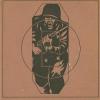
Battle of Britain - Wings of Victory - Hurricane -vs- Bf 109E
33LIMA posted a gallery image in Member's Albums
From the album Combat Sims
-

Battle of Britain - Wings of Victory - Hurricane -vs- Bf 109E
33LIMA posted a gallery image in Member's Albums
From the album Combat Sims
-

Battle of Britain - Wings of Victory - Hurricane -vs- Bf 109E
33LIMA posted a gallery image in Member's Albums
From the album Combat Sims
-
From the album Combat Sims
-

MSI NX8400GS 512MB Video Card -- would it be okay for SF2?
33LIMA replied to hawker111's topic in Thirdwire: Strike Fighters 2 Series - General Discussion
I ran FE2 (and occasionally, SF2 Europe) on a 512Mb 8300 GS and it ran okay, but a few more FPS and the ability to rack up the graphics options a bit higher would have been welcome. So the answer for an 8400 is probably 'yes', but a better card would definitely be a good idea if you want it to run well, rather than merely 'okay'. The table here shows the comparative specs of the cards in that series, with the right-hand column giving some idea of comparative performance: http://en.wikipedia.org/wiki/GeForce_8_series. My next card after the 8300 GS was a second hand 8800 GT and it was much better with SF2 sims and a big improvement on my other sims, like Steel Fury and IL-2 '46. I would say something of the performance of the old 8800GT is about the minimum standard you want for a decent experience with SF2. -
From the album IL-2 Battle of Stalingrad
Skin by Jaws2002 -
From the album IL-2 Battle of Stalingrad
Skin by vonPilsner -
From the album IL-2 Battle of Stalingrad
Stock skin -
From the album IL-2 Battle of Stalingrad
Skin by SPEKTRE76 -
From the album IL-2 Battle of Stalingrad
Skin by Parisek -
From the album IL-2 Battle of Stalingrad
Skin by Bearcat -
From the album IL-2 Battle of Stalingrad
Skin by Stab/JG26_5tuka -
From the album IL-2 Battle of Stalingrad
Skin by SPEKTRE76

